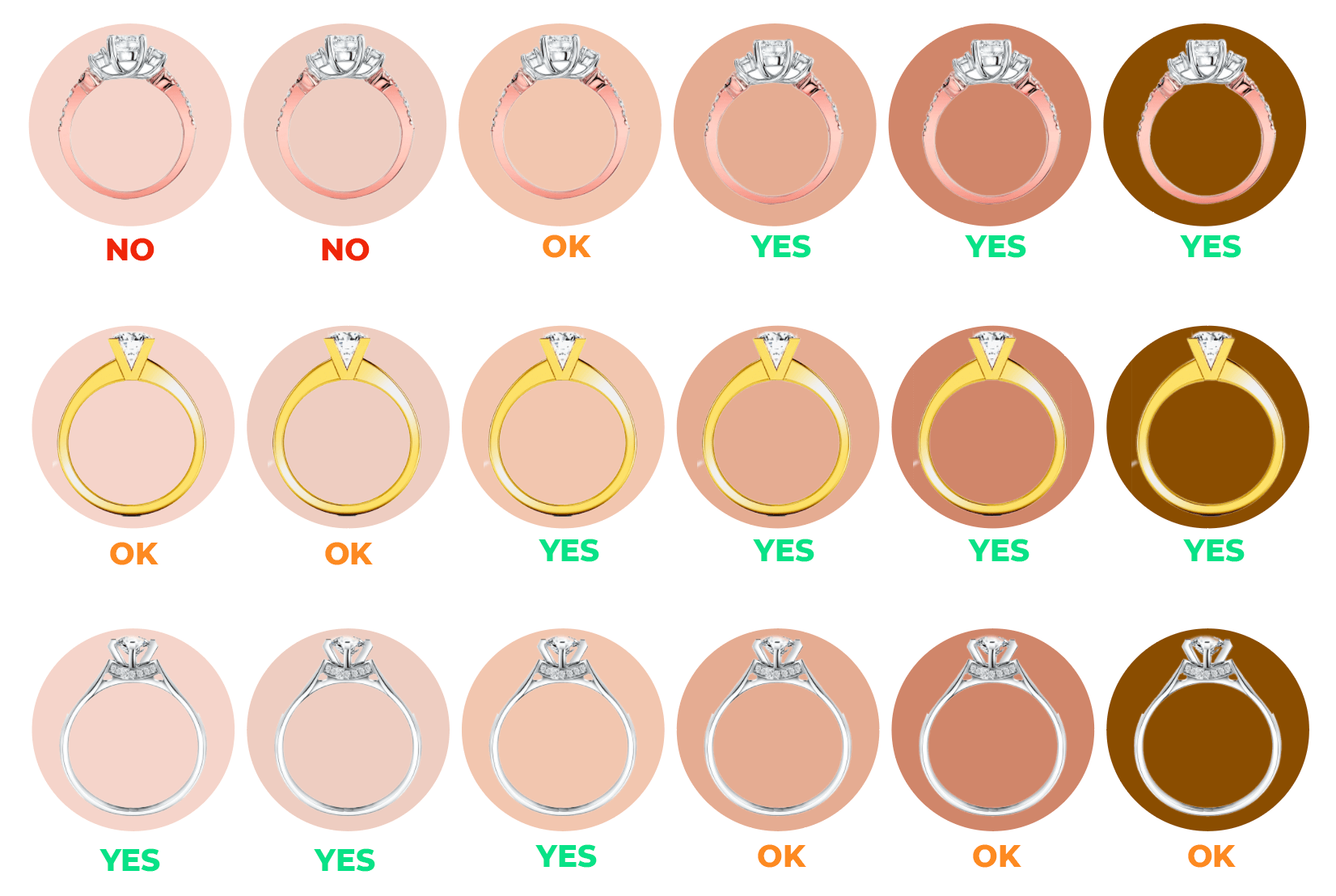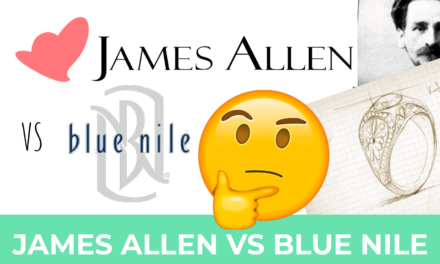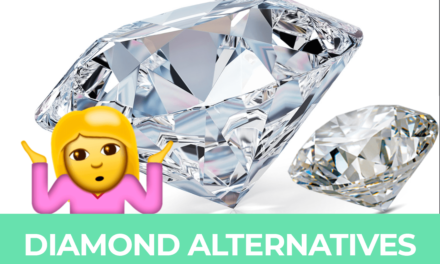My website is reader-supported. Buying through links on my site may result in me earning a CUSTOMER REFERRAL FEE at no extra cost to you.
Check out the latest deals at our top diamond vendor choice: James Allen
Rose Gold vs. Gold – Which One Is Better?
When it comes time to buy an engagement ring, there are many factors to consider. One of the biggest decisions you’ll have to make is what type of metal to choose for the ring. Gold and rose gold are both popular options, but which one is better? Here’s a look at the pros and cons of each metal so you can decide which is right for you.
Why there are different types of gold
Gold is a chemical element with symbol Au (from Latin: aurum) and atomic number 79, making it one of the higher atomic number elements that occur naturally. In its purest form, it is a bright reddish yellow; however, the term “gold” refers to gold in any metallic form or alloyed with other metals.
Gold isn’t just yellow; different types of gold exist with different chemical makeups including yellow, white, and even black and green types.
Yellow gold is a popular choice when making an engagement ring. Yellow gold is commonly alloyed with copper, zinc or silver while white gold is typically alloyed with metals like nickel and palladium to produce a different shade.
Rose gold is made by adding copper to yellow gold, giving it a pinkish hue.
The origin of rose gold
In 1842, British jeweler William Holden patented rose gold as a type of metal alloy that he sold under the name “American Pink.” His invention was an attempt to imitate the look of copper coins that were popular during his time period.
Why you won’t find a 24k yellow gold or rose gold engagement ring
You will have a difficult finding an engagement ring made out of pure gold. That’s because gold is not a very durable or strong metal on its own and. It’s too soft for most pieces of gold jewelry.
Most fine jewelry is made of 14k or 18k gold. Sometimes you’ll also find 10k gold jewelry.
10k, 14k and 18k gold refer to the percentage of pure gold contained in a ring, with 10k containing only 41.6% of pure gold, 14k 58% and 18k containing 75% of gold. The higher the percentage of pure gold the more “golden” the color.
10k is considered a relatively cheap alloy and in some countries isn’t even referred to as gold. That’s why some high-quality vendors such as James Allen do not offer 10k gold rings.
The most popular choice for an engagement ring is usually a 14k gold ring as it is cheaper than an 18k gold ring, yet more durable and similar in appearance. And this applies to both rose gold jewelry and yellow gold jewelry.
Rose gold vs yellow gold alloy
Rose gold (also called red gold, pink gold and sometimes Russian gold) is made by combining pure gold with copper and a bit of silver. It gets its rosy hue from the addition of copper, which causes a slight reddening in the metal’s color.
A common ratio for a rose gold ring is 75% gold, 22.5% copper and a small proportion of silver to complete the alloy. That would apply to an 18k rose gold ring. If you’d choose a 14k rose gold ring, you’d have about 58% pure gold and 42% of copper.
Rose gold is popular for jewelry because it has a warmer, more subtle look than traditional yellow gold. It also has a softer texture, making it more comfortable to wear.
A yellow gold ring on the other hand is a gold alloy made of yellow gold and copper, zinc, silver and sometimes nickel. Rose gold engagement rings obviously have a higher percentage of copper compared to yellow gold.
Which gold tone is best for which skin type?
Finding the gold tone for each skin type can be a little tricky. For example, most skin tones can pull off a yellow gold setting, but some skin tones look better with different gold tones. Follow the color guide below to see which skin tone would work best for your soon-to-be fiancee.
Fair Skin with Red Undertones
Rose gold will accentuate the pink undertone in your skin, hence it is not a good choice. Yellow gold is possible but not the best option. For a light skin color, we recommend white gold, especially if you also have blonde hair.
Fair Skin with Pale Undertone (cool skin tones)
While you can wear rose and yellow gold, white gold will always look best on your skin tone.
Lightly Tanned, Olive or Mediterranean Skin (warm skin tones)
Both, yellow and rose gold will look stunning on this type of skin color. The same applies to white gold. Basically, you can wear what you want.
Arabic, Fair African, and Dark Skin (warm skin tones)
Pink gold and yellow gold will also look absolutely beautiful on your skin tone. You could also wear white gold or silver, however especially when it’s small it might not be as visible as a gold tone.
South-East Asian Skin
You can wear both rose and gold color, with yellow gold being one of the most popular choices for this skin tone.
Here’s a color guide that can help you choose the optimal gold engagement ring setting:

Is rose gold cheaper than yellow gold and white gold?
The price is largely determined by the percentage of pure gold contained in your ring. For instance, an 18k gold ring will be more expensive than a 14k gold ring, no matter if yellow or rose.
However, a rose gold ring setting can sometimes be cheaper due to the high copper content, which is relatively cheap compared to other metals.
Keep in mind, though, that the price is also influenced by the style and size.
Do yellow, white and rose gold tarnish?
Two of the main benefits of rose gold are its unique, romantic color and its durability.
Rose gold is one of the most durable gold alloys thanks to the high copper content. Unlike white gold and yellow gold, it does not tarnish, however it can become darker over time.
The darker tone is caused by everyday wear and tear. It takes years to develop and is referred to as patina.
Patina is a thin coat that will cover your ring caused by oxidation. It actually looks quite beautiful and has a romantic feeling to it!
Does rose gold cause allergies?
As a rule of thumb, the higher the gold content in a ring the less likely are allergic reactions. When comparing rose and yellow gold, as well as white gold then yellow gold is the most hypoallergenic of all three.
Some people might have an allergic reaction to rose gold, unfortunately, as copper is not a hypoallergenic metal. So if you are prone to allergic reactions, you might want to consider yellow gold rings, white gold rings or a platinum ring instead.
Here’s a Summary of the Pros And Cons
The pros of rose gold:
- A popular choice amongst celebrities and considered romantic due to its reddish/pinkish color.
- Compared to yellow gold a rose gold ring setting can be slightly cheaper due to the low copper price.
- Rose gold is more durable compared to yellow gold thanks to the copper. Matches beautifully with olive, Mediterranean and darker skin tones.
The cons of rose gold:
- It can cause allergic reactions in some and is not a hypoallergenic metal. It is not as widely available as yellow and white gold. Might not be a good fit for pale skin with red undertone
The pros of yellow gold:
- The most hypoallergenic of all the three gold colors.
- The most popular gold choice for engagement rings and wedding rings of all times.
- Most malleable and easiest for jewelers to manipulate.
- Matches almost all skin tones.
- A good fit for diamonds with lower color grades, as the yellow gold ring setting picks up the color of the diamond.
The cons of yellow gold:
- It should be polished and cleaned regularly. It is subject to dents and scratches.





